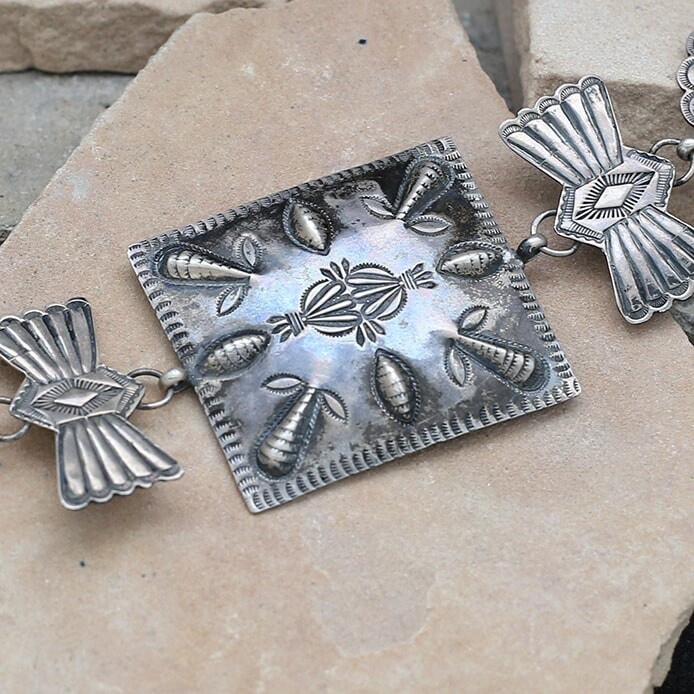Third phase link Concho belt UITA22
This link Concho belt has 9 oval concha's, 10 butterfly's and 1 square buckle. The buckle measures 2 x 2, with the oval concha's measure 1 x 1- 1/2 and the butterfly's measuring 1- 1/2 x 1/2. Over all length is 33". One of a kind piece.
Description: This beautiful Third phase link concho belt is a very unique piece of history. It dates to the late 1940's to the early 1950's. It bears the stamp of the "United Indian Traders Association" or UITA, along with a distinctive"arrowhead" stamp placed between the " I" and the "T". The United Indian Traders Association (UITA) was established on September 13, 1931 for the expressed purpose of authentication of Indian crafts.1 At the time, the UITA as an important player both in Indian cultural life and in advocating for the sale of authentic Indian arts and crafts.It is uncertain when use of UITA stamps ended. The general consensus among veteran collectors and dealers is that by late 1950's to early 1960's In addition to this stamp there is a number " 22" which refers to the UITA's member number assigned to the trading post from which this piece came from. In this case it is from the Dean Kirk Trading Post in Manuelito, N.M. His stamp was given to his Trading Post by the board of UITA sometime between 1946-1948.
Third Phase In the early 1900s, the third phase of the concha belt began when artists learned how to set turquoise into their pieces. Turquoise was first set by Navajos in silver around 1880. The use of turquoise in silver did not become prevalent until the 1890s, due to the scarcity of the stone. It was during this time period that the Colorado and Nevada turquoise mines began to export their turquoise to New Mexico and Arizona.Starting in the late 1910s, vertical silver butterflies were placed between the conchas. This was followed by link concha belts in the 1920s.This "Third Phase" of concho belt development, you started to see the "butterfly" appear between conchos and also the use of turquoise as an adornment on the face of a concho. A "butterfly" is simply another smaller concho in between the bigger conchos and its shape somewhat resembles that of a butterfly (a bow shape). Copper for the strap across the back becomes more prevalent than a silver bar as you go further on in time also. A belt with butterflies (and sometimes turquoise) from the early 1900s through the 1930s is generally thought of as "early third phase" and a belt from the 1940s through 70s (or so) would often be referred to as "vintage" while anything newer would be modern to contemporary. The word concho, sometimes spelled concha, comes from the Spanish word meaning shell. Some of the first "conchos" were made of melted silver dollars and resembled a shell—it is commonly thought this is how the name came about. In Spanish, the correct word is concha, with an a at the end and is pronounced like an ah sound. However, most people now-a-days refer to the Native American style belt as a concho belt, with an o. Although it is commonly said the Navajo (Dine’) borrowed the idea from Spaniards, thus the Concho Belt has become a long-standing Native tradition. Concho Belts reportedly began appearing in Navajo country in the late 1860s or early 1870s. Other Native Americans including the Zuni and Hopi also made traditional Concho Belts before long. The Navajo (Dine') learned how to work silver in the mid-nineteenth century. They had long appreciated silver jewelry that they acquired from Southwestern Hispanics and Plains tribes, but it is generally believed that they did not learn how to make metal jewelry until circa 1850 when Atsidi Sani became friends with a Mexican smith named Nakai Tsosi. Tsosi taught him how to work iron so that he could make bridles that he could sell to other Navajo. After the end of the Navajos' internment at Bosque Redondo near Fort Sumner in 1868, Nakai Tsosi taught Atsidi Sani how to smith silver for jewelry. He, in turn, taught his sons and other Navajos. A fine Concho Belt will be made of sterling silver (or better —. 999 silver and gold are also known to be used). They are often embellished with Turquoise (or other gemstones) and are usually mounted on a good leather strap. At times, copper, nickel silver-, or silver-plated overlay is also used, but these kinds of belts are usually thought of as lower grade and the price should be reflective. Another form of concho belt which appeared around mid-century was the "link" style concho belt. The link Concho belts are connected by rings between the conchos and fasten with a hook that can be attached at various places on the belt. No leather is used.

